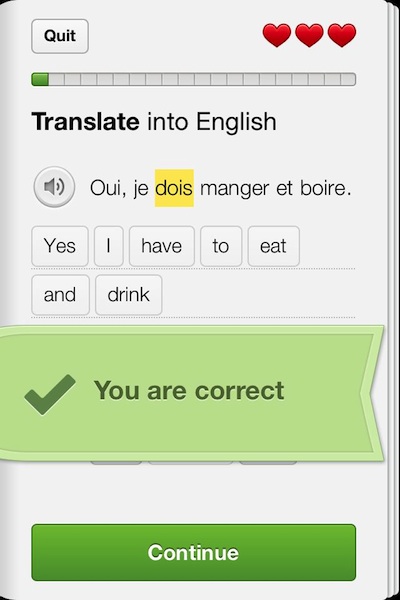A magazine where the digital world meets the real world.
On the web
- Home
- Browse by date
- Browse by topic
- Enter the maze
- Follow our blog
- Follow us on Twitter
- Resources for teachers
- Subscribe
In print
What is cs4fn?
- About us
- Contact us
- Partners
- Privacy and cookies
- Copyright and contributions
- Links to other fun sites
- Complete our questionnaire, give us feedback
Search:
Learning languages game by game

by Elena Hensinger
Knowing how to communicate in a foreign language is great. But learning and repeating vocabulary? Sounds less than exciting. However, games can change the way we learn.
Practice makes perfect
We all know that skills, whether playing a music instrument, solving sudoku puzzles, or learning languages, need practice. Some things are more fun to practise than others: playing a computer game in which you practise problem solving or logic is usually much more fun than, say, repeating vocabulary. But does it have to be this way? Can boring, repetitive, or laborious work be transformed into fun, quick and painless play?
Make it a game!
Well, what about bringing a smile to our face? That usually makes things easier, doesn't it? And what about breaking big tasks into smaller chunks that can be performed independently? And what about having some competition? Can I do this job better, faster or more precise than my friends? Sounds much more fun already!
These are some characteristics of "gamification", which makes use of the fact that people enjoy playing games and being in competition with each other. To do what? Loads of things. Businesses use gamification to attract customers and keep in touch with them, and people use it to build good habits and learn new languages.
Make it easy!
The popularity of smartphones and tablets helps make gamification work. We carry small computers everywhere we go. Imagine if you and I both have language homework to do. If I am doing my homework the traditional way, I have to find some time and space, mentally prepare myself for a task that requires focus and persistence, get out my notes and training material and spend 20 minutes repeating what I learned before. Phew, sounds like quite a hassle.
If you are using a gamification app, you can start it up whenever you have a few minutes to spare, even if you are waiting at a bus stop. You do not need any notes or writing utensils. The app remembers your progress. It varies the exercises to keep things interesting – translating from one language into English and the other way around, speaking, listening and reading. Instead of chapters it has levels that you can play through. You can also unlock some new levels after having successfully passed the previous ones. Each lesson consists of a pre-defined number of questions, and each mistake costs you a heart, like losing a life in any video game. If you manage to finish the lesson without losing any hearts, you get extra points. Oh, and of course, you can let your friends know about your learning and see how your scores compare to theirs!
Learning for free
Your homework sounds more fun than mine, right? Good news – you can learn a language the fun way with Duolingo. The Duolingo project was first started by Luis von Ahn and Severin Hacker, two academics from Carnegie Mellon University in the USA. There are several languages to choose from: French, German, Italian, Portuguese and Spanish for English-speaking learners. Since its launch in June 2012, the project has acquired over 5 million users. Best of all, it’s free, with no advertising.
But wait a minute. You might be wondering how Duolingo can be free. Creating any computer technology takes time and skills, and programmers need to be paid. Someone has to create a nice web page. Hosting the page online requires paying for a physical machine with internet connection, electricity, cooling, backups, lots of processing power. And you need to pay people to keep things running smoothly.
Ashton Kutcher’s collectively smart investment
Ashton Kutcher, at least, is hoping Duolingo can make money. The actor’s investment firm has helped fund the project. He knows that lots and lots of learners are collectively smart. They can translate documents while they learn. Sure, any one learner will make mistakes, but many learners working on the same sentence can create a good translation. It works like voting: the most common translation is probably correct. Duolingo gets money from companies and people who need some documents translated. They upload a document, which users collectively translate while they learn a language for free. Win-win!


